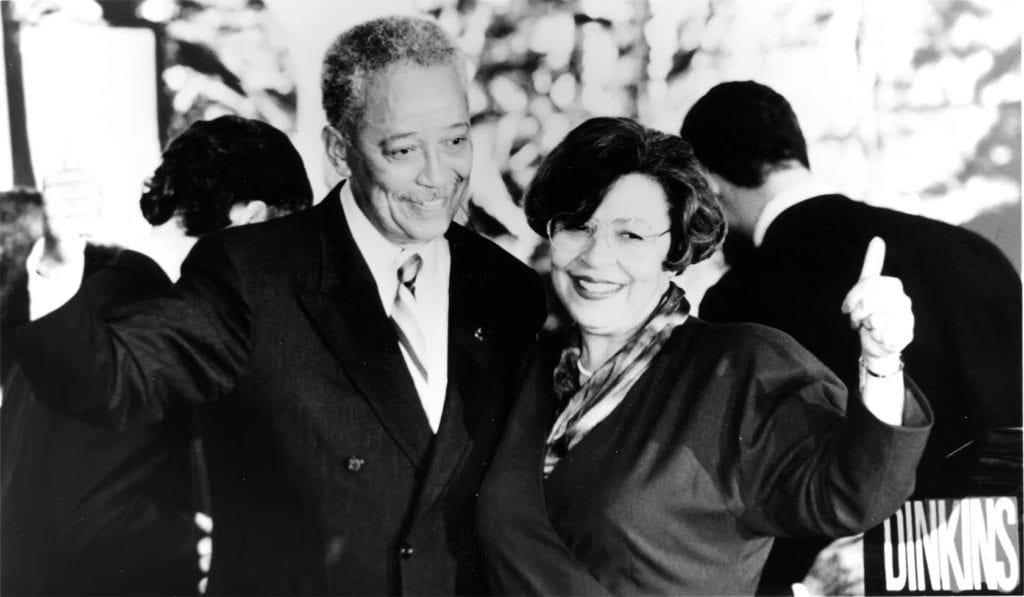
David N. Dinkins, the courtly former New York City mayor who presided over an upswing in the city’s fortunes through calm leadership in the midst of racial and financial challenges, died Nov. 30 in his Manhattan home at age 93.
Nurtured in the hothouse of Harlem club politics, the barber’s son rose to become Manhattan Borough president and the city’s first and only Black mayor. Dinkins defeated three-term Mayor Ed Koch in a volatile 1989 Democratic primary overshadowed by racial strife and went on to occupy Gracie Mansion by narrowly beating tough-talking federal prosecutor Rudy Giuliani in a “Do the Right Thing” final election in which voters cast ballots for hope over fear.
Citizens of the sprawling, chaotic metropolis turned to the dapper, soft-spoken political veteran as an alternative to Koch’s high-decibel, combative style, which repeatedly failed to soothe rising tensions in the city over high-profile racial clashes in the boroughs, especially the murder of Yusuf Hawkins by a crowd of white youths in the predominantly Italian-American working class Bensonhurst enclave of Brooklyn. In the lead-up to the 1989 contest, Dinkins also drew praise for his reasoned appeals for calm in the wake of the Central Park jogger case in which five Black youths were falsely accused of raping a white woman.
The handsome, mustachioed mayor, who favored double-breasted suits when he wasn’t wearing a satin Yankees bomber jacket, brought a marked change to City Hall, instilling confidence in investors who began bringing businesses and new construction back to the city after decades of corporate flight.
Despite a surge of new money and residents who brought much-needed renovation, economic vitality and inevitable complaints of gentrification to old neighborhoods, Dinkins’ reign was limited to a single term. Like Koch, Dinkins was evicted from City Hall after a renewed series of racial confrontations undermined voter faith in his ability to govern a city that challenges the definition of governable.
With unemployment rising in the city due to a national recession, the flashpoint of the 1993 contest was the Crown Heights riot in which Black youths battled with Orthodox Jews after two children were run over and one killed during a funeral procession for a leading Hasidic cleric. A Flatbush boycott of Korean-owned variety stores and the false perception, stoked by Giuliani and rabid tabloid coverage, of rising crime rates added to discontent among swing voters, who responded to Giuliani’s professed war on squeegee men and other quality-of-life issues.
As mayor, Dinkins promoted the Big Apple as a “gorgeous mosaic” and rallied broad support from diverse sectors to counter deep-seated issues of rising AIDS cases, crack-related violence, homelessness and disinvestment and put a spring back in the step of the city by revitalizing Times Square, long a symbol of New York’s decline, bringing new business into the city and spreading the benefits to Gotham’s long-neglected outer neighborhoods.
The consensus-driven mayor proved an able caretaker in moments of calm, but the City That Never Sleeps foiled his efforts time and again to hold the mosaic together. And at times, his political instincts and energy seemed to flag as he was forced to enact spending cuts to narrow looming budget deficits — bad news he was ineffective in selling to a city expecting more dynamic leadership.
During a memorable campaign swing in the final days of the 1993 election, Dinkins led reporters on visits to several Brooklyn schools and then stopped for lunch at the famed Sylvia’s restaurant in Harlem. With a cold rain pelting the pavement of the plaza outside the Adam Clayton Powell State Office Building, Dinkins called off a rally, leaving Jesse Jackson and Stevie Wonder stranded under umbrellas on windswept 125th Street, with the famed Motown vocalist singing a tribute he had written for the occasion to a set of puzzled scribes.
After his defeat, which Dinkins attributed to “racism, pure and simple,” the former mayor kept up his love of tennis, taught at Columbia University, hosted a radio show and serenely slipped into the role of elder political statesman.
Dinkins, born in Trenton, New Jersey, in 1927, briefly moved to Harlem with his mother after his parents divorced but soon returned to his father’s household. He excelled in high school, spent a stint in the Army and Marine Corps, and attended Howard University on the GI Bill. He met his future wife, Joyce Burrows, in Washington and after their marriage moved to Harlem.
His father-in-law, a real estate and insurance broker, had served several terms in the State Assembly and was one of the first Black political figures to join the inner circle of Tammany Hall, which controlled the city’s Democratic politics. Dinkins attended law school, built his practice after graduation and under the elder Burrows’ guidance began a gradual rise in clubhouse politics, winning election to the Assembly and eventually becoming president of the Board of Elections, a patronage-rich appointed position.
He ran twice for Manhattan Borough president before winning the post in 1985 and launching his bid for mayor four years later.
Dinkins’ wife Joyce died in October. He is survived by a son, David Jr., a daughter, Donna, and two grandchildren.






